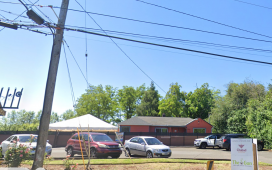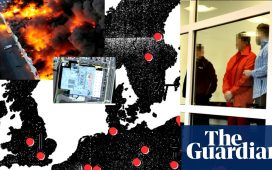At the end of a row of tidy redbrick bungalows in the Scottish town of Lockerbie is an empty plot, carefully landscaped now as a memorial garden. Two red tartan ribbons, tied on a leafless branch perhaps in private remembrance, flutter in a wintry gust.
Eleven of the street’s residents died when the wing section of Pan Am 103 crashed into Sherwood Crescent with the force of a meteorite on 21 December 1988, gouging a 30ft crater on this spot. The impact was such that some bodies were never recovered.
This once anonymous street was recreated in meticulous detail for the filming of the Sky Atlantic series Lockerbie: A Search for Truth, which was first screened last month and stars the Oscar winner Colin Firth as Dr Jim Swire, whose daughter Flora was killed when a bomb exploded on the Pan Am flight from London bound for New York.
Although the drama has been widely praised, some relatives of the 270 people who lost their lives in what remains the UK’s deadliest terrorist atrocity have questioned the need for such graphic depictions of the immediate aftermath. A spokesperson for the Victims of Pan Am Flight 103 group described it as “tragedy porn” to the Hollywood news site Deadline, while closer to home a Lockerbie resident who lost her sister and brother-in-law wrote in the Annandale Herald: “I don’t need to be reminded about the terrible scene that night.”
But for a generation born after 1988, this series may be their first exposure to the tangle of legal proceedings, conspiracy theories and international controversy that has become synonymous with the name of one small town in the south of Scotland.
With a second dramatisation airing on BBC One and Netflix later this year, a new BBC Scotland documentary, and the trial of the alleged bomb-maker starting in the US in May, Lockerbie is likely to remain in the spotlight this year, willingly or otherwise.
“It’s the most normal little town in the world, with a strong community, and people are just living their lives,” says the Rev Frances Henderson, a minister at Lochmaben and Lockerbie Churches. “You don’t see the trauma until suddenly you do. It’s there, being carried and dealt with, a trauma that is part of their lives and has shaped the last decades.”
Henderson has not watched the Colin Firth series herself, “not because I object to it but because I feel I’d have to psyche myself up to it,” she says.
“I think most people feel it’s been done respectfully but neither have I heard of many watching it because it’s too real. For those who weren’t there, who may be too young to remember, it’s perhaps useful, but not for those who were there.”
The series was based on Swire’s investigations into the bombing. He and many supporters have argued consistently for the innocence of Abdelbaset al-Megrahi, the Libyan intelligence officer who was convicted in 2001 at a specially convened Scottish court in the Netherlands of 270 counts of murder.
Swire believes that Megrahi, who was released on compassionate grounds by the Scottish government in 2009 after a diagnosis of terminal cancer and died in 2011 in Tripoli, was framed to deflect attention from Iranian and Syrian responsibility. This is rejected as a conspiracy theory by US victims’ relatives, who felt the series misrepresented the trial and portrayed Megrahi as “an innocent man that should be empathised with”.
Swire and other UK relatives continue to demand a public inquiry into the failure to take seriously or make public warnings that an attack on a Pan Am flight was imminent, while in May another Libyan, 72-year-old Abu Agila Masud, will go on trial in Washington accused of building the bomb that brought down the flight. He denies all charges.
Colin Smyth, the Scottish Labour MSP for the region, said: “There has been so much written about the trial and various conspiracy theories, but no one has ever spoken to me about any of that as a constituent.
after newsletter promotion
“People of Lockerbie didn’t choose for their town to be known for this, but they took their responsibility to the victims very seriously from the first night – like the couple who found a young man in their field and didn’t want to leave him so stood vigil until dawn, or the man who scooped up the body of a toddler and drove them into town so they weren’t left in the cold and wet.”
“For decades they have welcomed people with open arms as the families of the victims continue to visit their loved ones’ last resting place. Those relationships have sustained – you hear of relatives staying at family homes in Lockerbie even now.”
Those relationships are woven through the generations, thanks to the enduring scholarship programme between Lockerbie Academy and Syracuse University, New York, which lost 35 students in the disaster.
This Saturday Lori Carnochan, the chair of Tundergarth Kirks Trust, took another group of Syracuse students around the church and memorial room to the east of the town, where the plane’s nose cone came to rest.
“Visitors have this image in their head of Lockerbie and they’re all so pleasantly surprised – it’s not a sombre place. It’s a thriving, vibrant community, full of positivity and life, a fantastic place to raise a family,” she said.
Carnochan is leading plans to create a legacy museum at Tundergarth. “Children and young people need to understand the significance of the worst terrorist attack ever to have happened in the UK and the impact it had not only here in Lockerbie but all over the world, the changes that came about in aviation security and safety because of it.
“It’s so important for them to learn about the incredible acts of loving humanity by the people of Lockerbie in the aftermath, like the women who washed and distributed 11,000 items of personal artefacts and clothing back to the families that otherwise would have been destroyed.
“It’s a very difficult thing for many in the town to have to live with – it’s widely known many people here have some form of PTSD because of the attack, yet they still open their hearts and homes in the way that they did 36 years ago.”











